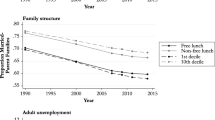Abstract
Since different races have unique fertility rates and migration patterns, performing school district enrollment projections by race and aggregating to a total may be more accurate than performing enrollment projections with all races combined. Twelve school districts in New Jersey of varying overall size and majority race percentages were used in this study to determine whether projecting enrollment by race or with all races combined is more accurate. Using historical enrollment data for a five-year period, the Cohort-Survival Ratio method was employed to project enrollment for a four-year period, 2003–04 through 2006–07. Projected enrollments were compared to actual enrollments in each district for both methods used for the purpose of determining whether district building capacity would be exceeded. Enrollments computed were district totals and enrollment by elementary, middle, and high school configurations. Percent differences were calculated for each district for the projection time period. The results showed that the projections with all races combined had lower percent differences as compared to the projections that were performed by race, particularly for smaller districts. However, the findings also showed that projecting enrollment by race might be suitable for larger districts with low majority race percentages. The results also demonstrated that projections by race are greater in magnitude than those projections performed with all races combined, which corroborates an earlier assertion by Keyfitz.
Similar content being viewed by others
References
Bernhardt, V. L., Pullum, T. W., Graham, S. N. (1983). Seattle’s small-area approach to forecasting enrollments at the school level. Paper presented at the Annual Meeting of the American Educational Research Association, Montreal, Quebec, Canada. (ERIC Document Reproduction Service No. ED 239 378).
Caffarella, E. P. (1983). Determining the accuracy of enrollment projection for school districts. CEFP Journal, 21(4), 14–16.
Castaldi, B. (1989). Educational facilities, planning, remodeling and management. New York: Allyn and Bacon.
Center for Social Policy. (1991). Kids count data book. Washington D.C: Annie Casey Foundation.
Colombo, L. J., Dekker, D. R., & Petronis, J. (1990). Counting heads. The American School Board Journal, 177(8), 20–21. 30.
George, M. V., Smith, S. K., Tayman, J., & Swanson, D. A. (2002). Population projections. In J. S. Siegel & D. A. Swanson (Eds.), Methods and materials of demography (2nd ed., pp. 561–595). Washington DC: Academic Press.
Glass, T. E., & Fulmer, C. L. (1991). Enrollment projections- factors and methods. CEFPI’s Educational Facility Planner, 29(6), 25–30.
Grip, R. S. (2004). Projecting enrollment in rural schools: A study of three Vermont school districts. Journal of Research in Rural Education, 19(3), 1–6.
Grip, R. S., & Young, J. W. (1999). The modified regression technique: A new method for public school enrollment projections. Planning and Changing, 30(3 & 4), 232–248.
Guerrero, E. S., & Kerr, O. (1987). Enrollment projections by race/ethnic origin, grade level, and administrative area 1985–2000. Miami, FL: Office of Educational Accountability Dade County Public Schools.
Hamilton, Rabinovitz and Szanton, Inc. (1979). Desegregating the Los Angeles Unified School District: First simulation series. Volume I. Los Angeles, CA.
Hill, L., & Johnson, H. P. (2002). Understanding the future of Californian’s fertility: The role of immigrants. San Francisco, CA: Public Policy Institute of California.
Keyfitz, N. (1977). Applied mathematical demography. New York: John Wiley & Sons.
Lows, R. (1988). Enrollment projections. DeKalb, IL: Illinois Association of School Business Officials.
McKibben, J. N. (1996). The impact of policy changes on forecasting for school districts. Population Research and Policy Review, 15(5–6), 527–536.
McKibben, J. N. (2006). School district planning and the 2010 decennial census: Data uses and needs. Journal of Economic and Social Measurement, 31(3–4), 221–232.
Murdock, S. H., & Ellis, D. R. (1991). Applied demography. Boulder, Colorado: Westview Press.
National Center for Education Statistics (2003). Homeschooling in the United States: 2003. Retrieved August 29, 2008, from: http://nces.ed.gov/pubs2006/homeschool/estimated.asp.
National Council of La Raza. (1987). School enrollment trends: 1981–1985. Perspectivas Publicas (Issue Brief). Washington, DC: Office of Research Advocacy and Legislation.
New Jersey Monthly Magazine. (2008). Top New Jersey High Schools 2008. Retrieved August 29, 2008, from: http://njmonthly.com/articles/towns_and_schools/highschoolrankings/top-highschools08.html.
New Jersey Statutes Annotated Title 18A, Sect. 38–13, (1967 & Supp. 1986).
Salley, C. D. (1979). Short-term enrollment forecasting for accurate budget planning. Journal of Higher Education, 50(3), 323–333.
Schellenberg, S. J., & Stephens, C. E. (1987). Enrollment projection: Variations on a theme. Paper presented at the Annual Meeting of the American Educational Research Association, Washington D.C., (ERIC Document Reproduction Service No. ED 283 879).
Shaw, R. C. (1984). Enrollment forecasting: What methods work best? NASSP Bulletin, 68(468), 52–58.
Sweeney, S. H., & Middleton, E. J. (2005). Multiregional cohort enrollment projections: Matching methods to enrollment policies. Population Space and Place, 11(5), 361–380.
Weldon, W., Hurwitz, E., & Menacker, J. (1989). Enrollment projections: Techniques and financial implications. School Business Affairs, 55(10), 28–31.
Wilmore, E. (1995). A school in change. ERIC Document Reproduction Service No. ED 391 260.
Author information
Authors and Affiliations
Corresponding author
Rights and permissions
About this article
Cite this article
Grip, R.S. Does Projecting Enrollments by Race Produce More Accurate Results in New Jersey School Districts?. Popul Res Policy Rev 28, 747–771 (2009). https://doi.org/10.1007/s11113-009-9127-8
Received:
Accepted:
Published:
Issue Date:
DOI: https://doi.org/10.1007/s11113-009-9127-8




